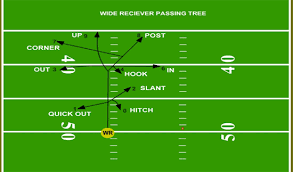Implementing a passing tree into your flag football offense can be beneficial for efficiency in performance, but also for the enjoyment and satisfaction of the players.
A passing tree is a standardized numbering system in which set passing routes are pre-arranged into a format which allows for easy learning, memorization, and recollection. While passing trees are flexible and can be adapted to fit any offensive system, they are foundationally the same across the board.
Each of the passing routes used in an offense is assigned a number. For example:
1 – Slant 4 – Corner
2 – Out 5 – Post
3 – In 6 - Go/Fly
Oftentimes, the passing tree is set up so that odd numbers are routes that go in one direction, like towards the center of the field, while the even numbers are routes towards the sideline. Again, this can be adapted to program preference. With these routes determined and implemented, play calling will become simplified and exciting for both the coach and the players.

Using the tree, passing offensive plays can be called using a simplified name. Creating a play name using the tree involves two steps. First, is the formation from which the play will be ran. For example, “trips,” “shotgun, or “I formation. Next, using the available receivers for the formation, from the left side of the field to the right, each one is assigned a route using the passing tree.
Combining the formation with the route directions, you have created a play name to call during the game. Let’s use this example… “Trips Left 125.”

This play call tells us that we will be lined up with three receivers on the left side of the field. The receiver furthest left from the quarterback will be running a “1” route, or a slant. The next receiver in will run a “2” route, or an out. Finally, the third receiver in will be running a post towards the middle of the field, or route “5.”
While a passing tree can be implemented into all offensive plays as discussed, it also offers advantages for in-game situations.
Audibles
For those moments when you call a play from the sideline, and the defense seems to line up as if they heard exactly what you intended on running, a passing tree will save you from having to call time out. Simply apply an audible, or allow your quarterback to if skilled enough, and take advantage of what the defense has given you.
Being able to have a simplified audible system in place will allow everyone on the field to know the change in plans. Should you only want to change the route for only one of the receivers, it is as simple as getting their attention and calling out the route you want them to change to.
No Huddle
Finally, a passing tree allows an offense of all skill levels to effectively run a no huddle, or hurry up, offense. Whether the coach is calling the play as the players are lining up on the ball, or the duties are left to a well-versed quarterback, huddles will become a thing of the past as your team rolls down the field like professionals.
If you are planning on implementing a passing tree for your no-huddle offense, using a Playbook Wristband will allow you and your players to stay on the same page, even while they are on the field.

Great Idea… What do I do now?
You now know the benefits of having a simplified passing tree system incorporated into your offensive tool box. We discussed why it is useful and how to create one for your team. Next, we will discuss the best ways to incorporate the tree to your players and get them running the system like an ace. Just like their favorite role model NFL quarterback, your team will enjoy the trust and independence they feel when they are performing like a professional.
Do you have experience using a passing route tree in your flag football offense? We would love to hear any tips that you found useful.
Comments
This was good
A passing tip for football could be when someone just throws it up and there’s a pile of people move to the side because it’s most likely to bounce and you could catch it
this was a good article to read